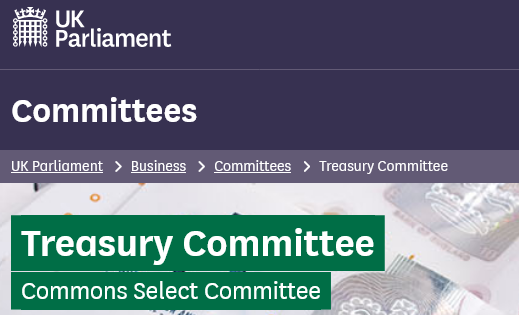Published on 1st December 2023
It has inexplicably fallen below the radar that the Treasury Select Committee on 22nd November finally succeeded in cornering the Bank of England about key features of their bond buying (Quantitative Easing) and selling (Quantitative Tightening).
The upshot is that further questioning, apart from nailing down one or two details about how the new Bank Levy can be used, can now focus solely on the elephant in the room: the nature and degree of the Bank’s independence.
The questioning was led by Danny Kruger MP, and seven points of key importance were confirmed, with one point about the Bank Levy still needing clarity.
Firstly, we have absolute clarity that the Bank of England’s dealings have caused and are causing major losses, just as in the past they produced profits. Realized losses are passed back to HM Treasury under its indemnity.
Secondly, when losses are passed back to HM Treasury they affect ‘fiscal decisions’ i.e. they affect public spending, the rates of taxation and the levels of public borrowing. This was made obvious the following day when the figures backing the Autumn Statement included the large loss that had been passed back by the Bank within the list of income and expense items on the public budget.
Thirdly, the losses add up to the same amount whether the Bank sells the bonds or keeps them. With a portfolio of about £700 billion and an average maturity of 7 years, the portfolio presents a loss of £49 billion for every 1% that interest rates have risen in the same maturity since the bonds were bought. 1% x £700 billion x 7 = £49 billion. Since interest rates have risen by approximately 3% since the bonds were bought, the Bank would realize a loss of three times this amount – or £147 billion – if it sold the entire portfolio now.
Fourthly, holding the bonds causes a major loss, and every day. The Bank is receiving about 2¼% as coupon income on the bonds it owns, and it is paying 5¼% (its Base Rate) on the balances that it requires retail and commercial banks to hold with it on their Reserve Accounts. The Reserve Account balances fund the Bank’s QE bond portfolio. The Bank is thus losing 3% in net interest every day on the £700 billion, or £21 billion per annum. Over a 7-year period, if interest rates stay where they are, the Bank will lose the same £147 billion (£21 billion x 7).
Fifthly, the Bank views itself as having a blanket and irrevocable indemnity from HMTreasury (i.e from the taxpayer) for the losses it incurs when it sells bonds.
Sixthly, it need not – and actually cannot – use the Bank Levy to meet those losses instead. The Bank Levy is the new mechanism for funding the Bank’s costs, instead of its not paying its Base Rate on part of the balances that it requires retail and commercial banks to hold with it on their Reserve Accounts.
This leads to the point that still needs to be covered off – whether it can use the proceeds of the Bank Levy to cover its net interest deficit incurred as it holds on to the bonds. If the Bank Levy is one of the revenue lines in the Bank’s Profit & Loss Account and the net interest deficit is one of the expense lines in it, the two naturally get blended – if no actions are taken to earmarked specific revenues against specific expenses – to reach the Bank’s operating profit or loss.
The seventh and final point confirmed by the Bank is the most spectacular and it was explicitly stated by the Bank during the Treasury Committee session: with the benefit of the indemnity from HMTreasury the Bank need take no heed at all of the risks to the public exchequer that derive from its own ‘monetary policy’.
This formulation needs now to be subjected to rigorous debate. It is an indicator of the Bank’s ‘independence’: it can undertake operations which it defines as ‘monetary policy’, meaning they are within its remit and cannot be challenged. It is just fine and normal, according to the Bank, that the results of these policies can have major impacts on spending, borrowing and taxation: the Bank’s ‘monetary policy’ apparently needs to be considered in isolation from its impacts. A £147 billion loss to the public exchequer? Not our problem, according to the Bank.
This is why the questioning was so important. Apart from ascertaining as we go along both the monthly losses and/or the lump sum losses, and nailing down whether the revenue from the Bank Levy can be used to cushion the monthly losses, discussion can now focus solely on the seventh point: is it realistic that we have a central bank that can go so far ‘off the reservation’ as far as the country at large is concerned but not, apparently, stray from its remit?
The nature and degree of the Bank’s ‘independence’ now needs to be properly debated, rather than the Bank being treated as a sacred cow operating within its own inviolable preserves and ultimately answerable only to itself.

